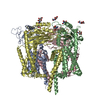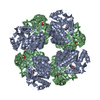+ Open data
Open data
- Basic information
Basic information
| Entry | Database: EMDB / ID: EMD-30606 | |||||||||
|---|---|---|---|---|---|---|---|---|---|---|
| Title | Structure of PKD1L3-CTD/PKD2L1 in apo state | |||||||||
 Map data Map data | apo | |||||||||
 Sample Sample |
| |||||||||
| Function / homology |  Function and homology information Function and homology informationdetection of chemical stimulus involved in sensory perception of sour taste / detection of chemical stimulus involved in sensory perception of taste / sensory perception of sour taste / response to water /  calcium-activated potassium channel activity / cellular response to pH / detection of mechanical stimulus / calcium-activated potassium channel activity / cellular response to pH / detection of mechanical stimulus /  cation channel complex / muscle alpha-actinin binding / cellular response to acidic pH ...detection of chemical stimulus involved in sensory perception of sour taste / detection of chemical stimulus involved in sensory perception of taste / sensory perception of sour taste / response to water / cation channel complex / muscle alpha-actinin binding / cellular response to acidic pH ...detection of chemical stimulus involved in sensory perception of sour taste / detection of chemical stimulus involved in sensory perception of taste / sensory perception of sour taste / response to water /  calcium-activated potassium channel activity / cellular response to pH / detection of mechanical stimulus / calcium-activated potassium channel activity / cellular response to pH / detection of mechanical stimulus /  cation channel complex / muscle alpha-actinin binding / cellular response to acidic pH / cation channel complex / muscle alpha-actinin binding / cellular response to acidic pH /  sodium channel activity / non-motile cilium / inorganic cation transmembrane transport / ciliary membrane / smoothened signaling pathway / monoatomic cation transport / monoatomic cation channel activity / potassium ion transmembrane transport / sodium channel activity / non-motile cilium / inorganic cation transmembrane transport / ciliary membrane / smoothened signaling pathway / monoatomic cation transport / monoatomic cation channel activity / potassium ion transmembrane transport /  calcium channel complex / protein tetramerization / calcium channel complex / protein tetramerization /  calcium channel activity / calcium channel activity /  actin cytoskeleton / cytoplasmic vesicle / actin cytoskeleton / cytoplasmic vesicle /  carbohydrate binding / protein homotetramerization / transmembrane transporter binding / carbohydrate binding / protein homotetramerization / transmembrane transporter binding /  receptor complex / receptor complex /  calcium ion binding / calcium ion binding /  endoplasmic reticulum / endoplasmic reticulum /  membrane / identical protein binding / membrane / identical protein binding /  plasma membrane / plasma membrane /  cytosol cytosolSimilarity search - Function | |||||||||
| Biological species |   Mus musculus (house mouse) Mus musculus (house mouse) | |||||||||
| Method |  single particle reconstruction / single particle reconstruction /  cryo EM / Resolution: 3.4 Å cryo EM / Resolution: 3.4 Å | |||||||||
 Authors Authors | Su Q / Chen M / Li B / Wang Y / Jing D / Zhan X / Yu Y / Shi Y | |||||||||
| Funding support |  China, 2 items China, 2 items
| |||||||||
 Citation Citation |  Journal: Nat Commun / Year: 2021 Journal: Nat Commun / Year: 2021Title: Structural basis for Ca activation of the heteromeric PKD1L3/PKD2L1 channel. Authors: Qiang Su / Mengying Chen / Yan Wang / Bin Li / Dan Jing / Xiechao Zhan / Yong Yu / Yigong Shi /   Abstract: The heteromeric complex between PKD1L3, a member of the polycystic kidney disease (PKD) protein family, and PKD2L1, also known as TRPP2 or TRPP3, has been a prototype for mechanistic characterization ...The heteromeric complex between PKD1L3, a member of the polycystic kidney disease (PKD) protein family, and PKD2L1, also known as TRPP2 or TRPP3, has been a prototype for mechanistic characterization of heterotetrametric TRP-like channels. Here we show that a truncated PKD1L3/PKD2L1 complex with the C-terminal TRP-fold fragment of PKD1L3 retains both Ca and acid-induced channel activities. Cryo-EM structures of this core heterocomplex with or without supplemented Ca were determined at resolutions of 3.1 Å and 3.4 Å, respectively. The heterotetramer, with a pseudo-symmetric TRP architecture of 1:3 stoichiometry, has an asymmetric selectivity filter (SF) guarded by Lys2069 from PKD1L3 and Asp523 from the three PKD2L1 subunits. Ca-entrance to the SF vestibule is accompanied by a swing motion of Lys2069 on PKD1L3. The S6 of PKD1L3 is pushed inward by the S4-S5 linker of the nearby PKD2L1 (PKD2L1-III), resulting in an elongated intracellular gate which seals the pore domain. Comparison of the apo and Ca-loaded complexes unveils an unprecedented Ca binding site in the extracellular cleft of the voltage-sensing domain (VSD) of PKD2L1-III, but not the other three VSDs. Structure-guided mutagenic studies support this unconventional site to be responsible for Ca-induced channel activation through an allosteric mechanism. | |||||||||
| History |
|
- Structure visualization
Structure visualization
| Movie |
 Movie viewer Movie viewer |
|---|---|
| Structure viewer | EM map:  SurfView SurfView Molmil Molmil Jmol/JSmol Jmol/JSmol |
| Supplemental images |
- Downloads & links
Downloads & links
-EMDB archive
| Map data |  emd_30606.map.gz emd_30606.map.gz | 49.3 MB |  EMDB map data format EMDB map data format | |
|---|---|---|---|---|
| Header (meta data) |  emd-30606-v30.xml emd-30606-v30.xml emd-30606.xml emd-30606.xml | 12.1 KB 12.1 KB | Display Display |  EMDB header EMDB header |
| Images |  emd_30606.png emd_30606.png | 249.1 KB | ||
| Archive directory |  http://ftp.pdbj.org/pub/emdb/structures/EMD-30606 http://ftp.pdbj.org/pub/emdb/structures/EMD-30606 ftp://ftp.pdbj.org/pub/emdb/structures/EMD-30606 ftp://ftp.pdbj.org/pub/emdb/structures/EMD-30606 | HTTPS FTP |
-Related structure data
| Related structure data |  7d7eMC  7d7fC M: atomic model generated by this map C: citing same article ( |
|---|---|
| Similar structure data |
- Links
Links
| EMDB pages |  EMDB (EBI/PDBe) / EMDB (EBI/PDBe) /  EMDataResource EMDataResource |
|---|---|
| Related items in Molecule of the Month |
- Map
Map
| File |  Download / File: emd_30606.map.gz / Format: CCP4 / Size: 52.7 MB / Type: IMAGE STORED AS FLOATING POINT NUMBER (4 BYTES) Download / File: emd_30606.map.gz / Format: CCP4 / Size: 52.7 MB / Type: IMAGE STORED AS FLOATING POINT NUMBER (4 BYTES) | ||||||||||||||||||||||||||||||||||||||||||||||||||||||||||||||||||||
|---|---|---|---|---|---|---|---|---|---|---|---|---|---|---|---|---|---|---|---|---|---|---|---|---|---|---|---|---|---|---|---|---|---|---|---|---|---|---|---|---|---|---|---|---|---|---|---|---|---|---|---|---|---|---|---|---|---|---|---|---|---|---|---|---|---|---|---|---|---|
| Annotation | apo | ||||||||||||||||||||||||||||||||||||||||||||||||||||||||||||||||||||
| Voxel size | X=Y=Z: 1.087 Å | ||||||||||||||||||||||||||||||||||||||||||||||||||||||||||||||||||||
| Density |
| ||||||||||||||||||||||||||||||||||||||||||||||||||||||||||||||||||||
| Symmetry | Space group: 1 | ||||||||||||||||||||||||||||||||||||||||||||||||||||||||||||||||||||
| Details | EMDB XML:
CCP4 map header:
| ||||||||||||||||||||||||||||||||||||||||||||||||||||||||||||||||||||
-Supplemental data
- Sample components
Sample components
-Entire : Heterotetrameric TRP channel of PKD1L3/PKD2L1 complex
| Entire | Name: Heterotetrameric TRP channel of PKD1L3/PKD2L1 complex |
|---|---|
| Components |
|
-Supramolecule #1: Heterotetrameric TRP channel of PKD1L3/PKD2L1 complex
| Supramolecule | Name: Heterotetrameric TRP channel of PKD1L3/PKD2L1 complex / type: complex / ID: 1 / Parent: 0 / Macromolecule list: #1-#2 |
|---|---|
| Source (natural) | Organism:   Mus musculus (house mouse) Mus musculus (house mouse) |
| Recombinant expression | Organism:   Homo sapiens (human) Homo sapiens (human) |
-Macromolecule #1: Polycystic kidney disease 2-like 1 protein
| Macromolecule | Name: Polycystic kidney disease 2-like 1 protein / type: protein_or_peptide / ID: 1 / Number of copies: 3 / Enantiomer: LEVO |
|---|---|
| Source (natural) | Organism:   Mus musculus (house mouse) Mus musculus (house mouse) |
| Molecular weight | Theoretical: 69.234734 KDa |
| Recombinant expression | Organism:   Homo sapiens (human) Homo sapiens (human) |
| Sequence | String: MGSAGWSHPQ FEKGGGSGGG SGGSAWSHPQ FEKGSAAATL VSSCCLHICR SIRGLWGTTL TENTAENREL YVKTTLRELV VYIVFLVDI CLLTYGMTSS SAYYYTKVMS ELFLHTPSDS GVSFQTISSM SDFWDFAQGP LLDSLYWTKW YNNQSLGRGS H SFIYYENL ...String: MGSAGWSHPQ FEKGGGSGGG SGGSAWSHPQ FEKGSAAATL VSSCCLHICR SIRGLWGTTL TENTAENREL YVKTTLRELV VYIVFLVDI CLLTYGMTSS SAYYYTKVMS ELFLHTPSDS GVSFQTISSM SDFWDFAQGP LLDSLYWTKW YNNQSLGRGS H SFIYYENL LLGAPRLRQL RVRNDSCVVH EDFREDILNC YDVYSPDKED QLPFGPQNGT AWTYHSQNEL GGSSHWGRLT SY SGGGYYL DLPGSRQASA EALQGLQEGL WLDRGTRVVF IDFSVYNANI NLFCILRLVV EFPATGGTIP SWQIRTVKLI RYV NNWDFF IVGCEVVFCV FIFYYVVEEI LEIHLHRLRY LSSVWNILDL VVILLSIVAV GFHIFRTLEV NRLMGKLLQQ PDTY ADFEF LAFWQTQYNN MNAVNLFFAW IKIFKYISFN KTMTQLSSTL ARCAKDILGF AIMFFIVFFA YAQLGYLLFG TQVEN FSTF VKCIFTQFRI ILGDFDYNAI DNANRILGPV YFVTYVFFVF FVLLNMFLAI INDTYSEVKE ELAGQKDQLQ LSDFLK QSY NKTLLRLRLR KERVSDVQKV LKGGEPEIQF EDFTSTLREL G |
-Macromolecule #2: Polycystic kidney disease protein 1-like 3
| Macromolecule | Name: Polycystic kidney disease protein 1-like 3 / type: protein_or_peptide / ID: 2 / Number of copies: 1 / Enantiomer: LEVO |
|---|---|
| Source (natural) | Organism:   Mus musculus (house mouse) Mus musculus (house mouse) |
| Molecular weight | Theoretical: 62.541914 KDa |
| Recombinant expression | Organism:   Homo sapiens (human) Homo sapiens (human) |
| Sequence | String: MGSAGDYKDH DGDYKDHDID YKDDDDKGSA AAPIYTAPAM NNLAKPTRKA WKKQLSKLTG GTLVQILFLT LLMTTVYSAK DSSRFFLHR AIWKRFSHRF SEIKTVEDFY PWANGTLLPN LYGDYRGFIT DGNSFLLGNV LIRQTRIPND IFFPGSLHKQ M KSPPQHQE ...String: MGSAGDYKDH DGDYKDHDID YKDDDDKGSA AAPIYTAPAM NNLAKPTRKA WKKQLSKLTG GTLVQILFLT LLMTTVYSAK DSSRFFLHR AIWKRFSHRF SEIKTVEDFY PWANGTLLPN LYGDYRGFIT DGNSFLLGNV LIRQTRIPND IFFPGSLHKQ M KSPPQHQE DRENYGAGWV PPDTNITKVD SIWHYQNQES LGGYPIQGEL ATYSGGGYVV RLGRNHSAAT RVLQHLEQRR WL DHCTKAL FVEFTVFNAN VNLLCAVTLI LESSGVGTFL TSLQLDSLTS LQSSERGFAW IVSQVVYYLL VCYYAFIQGC RLK RQRLAF FTRKRNLLDT SIVLISFSIL GLSMQSLSLL HKKMQQYHCD RDRFISFYEA LRVNSAVTHL RGFLLLFATV RVWD LLRHH AQLQVINKTL SKAWDEVLGF ILIIVVLLSS YAMTFNLLFG WSISDYQSFF RSIVTVVGLL MGTSKHKEVI ALYPI LGSL LVLSSIILMG LVIINLFVSA ILIAFGKERK ACEKEATLTD MLLQKLSSLL GIRLHQNPSE EHADNTG |
-Macromolecule #3: 2-acetamido-2-deoxy-beta-D-glucopyranose
| Macromolecule | Name: 2-acetamido-2-deoxy-beta-D-glucopyranose / type: ligand / ID: 3 / Number of copies: 10 / Formula: NAG |
|---|---|
| Molecular weight | Theoretical: 221.208 Da |
| Chemical component information |  ChemComp-NAG: |
-Macromolecule #4: CALCIUM ION
| Macromolecule | Name: CALCIUM ION / type: ligand / ID: 4 / Number of copies: 3 / Formula: CA |
|---|---|
| Molecular weight | Theoretical: 40.078 Da |
-Experimental details
-Structure determination
| Method |  cryo EM cryo EM |
|---|---|
 Processing Processing |  single particle reconstruction single particle reconstruction |
| Aggregation state | particle |
- Sample preparation
Sample preparation
| Buffer | pH: 7.5 |
|---|---|
| Vitrification | Cryogen name: ETHANE |
- Electron microscopy
Electron microscopy
| Microscope | FEI TITAN KRIOS |
|---|---|
| Electron beam | Acceleration voltage: 300 kV / Electron source:  FIELD EMISSION GUN FIELD EMISSION GUN |
| Electron optics | Illumination mode: FLOOD BEAM / Imaging mode: BRIGHT FIELD Bright-field microscopy Bright-field microscopy |
| Image recording | Film or detector model: GATAN K3 BIOQUANTUM (6k x 4k) / Average electron dose: 50.0 e/Å2 |
| Experimental equipment |  Model: Titan Krios / Image courtesy: FEI Company |
- Image processing
Image processing
| Initial angle assignment | Type: MAXIMUM LIKELIHOOD |
|---|---|
| Final angle assignment | Type: MAXIMUM LIKELIHOOD |
| Final reconstruction | Resolution.type: BY AUTHOR / Resolution: 3.4 Å / Resolution method: FSC 0.143 CUT-OFF / Number images used: 549716 |
 Movie
Movie Controller
Controller



















